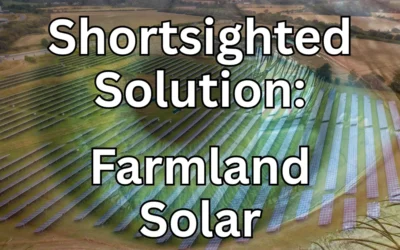Anna Jacobs
Why Should You Care About Carbon Capture
Every action we take—every mile we drive, every meal we eat—leaves a mark on the planet. For the average American, that mark adds up to 16 tons of CO₂ emissions per year, one of the highest per capita rates in the world. But what if there were a way to not only offset your personal carbon footprint but also support farmers, regenerate soil, and create local jobs?
At Dynamic Carbon Credits, we believe carbon capture can be more than just a tool for fighting climate change—it can be a force for good. By turning the fight against emissions into an opportunity to heal the planet and empower communities, we’re redefining what it means to take responsibility for your impact.
When it comes to corporate climate action, two terms often dominate the conversation: Scope 1 emissions and additionality. These concepts are more than just jargon—they are the foundation of credible sustainability strategies. For Fortune 500 companies, understanding how these principles intersect is key to avoiding greenwashing and achieving real progress in reducing greenhouse gas (GHG) emissions.
In this article, we’ll explore the relationship between Scope 1 emissions and additionality, why they matter, and how Dynamic Carbon Credits’ innovative Direct Air Capture by Plants (DAC-P) solution offers a groundbreaking way to address both.
What Are Scope 1 Emissions?
Let’s start with the basics. Scope 1 emissions are direct emissions from sources that a company owns or controls. These include:
- Fuel combustion in company-owned vehicles.
- Emissions from on-site boilers, furnaces, or generators.
- Fugitive emissions, such as methane leaks from pipelines or refrigerant leaks.
Scope 1 emissions are the most tangible and measurable part of a company’s carbon footprint. They’re also the hardest to ignore because they stem directly from a company’s operations. For example, a logistics company’s fleet of diesel trucks or a manufacturing plant’s natural gas-powered machinery are classic Scope 1 emission sources.
Why Scope 1 Emissions Are a Big Deal
Scope 1 emissions are often the largest and most visible contributor to a company’s carbon footprint. They’re also the most scrutinized by regulators, investors, and customers. Reducing these emissions is not just about compliance—it’s about demonstrating leadership in sustainability.
However, cutting Scope 1 emissions can be challenging. For industries like manufacturing, transportation, and energy, many processes are inherently carbon-intensive. While switching to renewable energy or electrifying fleets can help, these solutions often require significant capital investment and long timelines.
Enter Additionality: The Gold Standard for Carbon Credits
Now, let’s talk about additionality. In the world of carbon credits, additionality ensures that a project creates emissions reductions that wouldn’t have happened otherwise. This principle is critical for ensuring that carbon offsets represent real, measurable, and meaningful climate action.
For example:
- A wind farm built in a region where renewable energy is already mandated by law is not additional.
- A project that restores degraded farmland with carbon-sequestering crops is additional, as it wouldn’t have occurred without the financial support provided by carbon credits.
Additionality is the key to avoiding greenwashing, where companies claim to offset emissions using credits from projects that don’t actually reduce global GHG levels.
How Scope 1 Emissions and Additionality Intersect
Here’s where things get interesting. Companies with unavoidable Scope 1 emissions often turn to carbon credits to offset their footprint. But not all carbon credits are created equal. If the credits come from non-additional projects, the company risks undermining its sustainability claims—and its reputation.
To credibly offset Scope 1 emissions, companies need high-integrity carbon credits that meet strict additionality criteria. This ensures that the offsets represent real, incremental reductions in global emissions.
Dynamic Carbon Credits: A New Era of Additionality
At Dynamic Carbon Credits, we’re redefining additionality with our proprietary Direct Air Capture by Plants (DAC-P) solution. Unlike traditional reforestation projects, which can take decades to sequester carbon, DAC-P uses specially cultivated plants optimized for rapid carbon uptake through photosynthesis.
Here’s how it works:
- Specialized Plant Cultivation: We grow high-carbon-sequestering plants on degraded land that would otherwise remain barren.
- Biochar Production: After harvesting, the plants are converted into biochar, a stable form of carbon that can be stored in soil for centuries.
- Measurable Carbon Removal: Each ton of biochar represents a quantifiable amount of CO2 removed from the atmosphere, verified by third-party auditors.
This process not only removes carbon but also restores soil health, combats erosion, and supports regenerative agriculture practices. It’s a win-win for the planet and local communities.
Case Study: Tackling Scope 1 Emissions with DAC-P
Let’s look at a hypothetical example. Imagine a Fortune 500 logistics company with a fleet of diesel trucks. Despite efforts to electrify its fleet, the company still has significant Scope 1 emissions due to long-haul routes where electric vehicle infrastructure is limited.
To address this, the company partners with Dynamic Carbon Credits to purchase DAC-P offsets.
Here’s the impact:
- Carbon Removal: The company offsets its fleet’s annual emissions by purchasing DAC-P credits, which represent verified CO₂ removal through biochar production.
- Transparency: Detailed reports show the additionality and permanence of the offsets, ensuring stakeholders that the credits are credible.
- Community Support: The DAC-P projects improve soil health and support regenerative farming in rural areas, creating co-benefits beyond carbon removal.
By combining internal emissions reductions with high-integrity offsets, the company achieves carbon neutrality for its fleet while enhancing its reputation as a sustainability leader.
A Vision for the Future
Beau Parmenter, a leader in sustainability innovation at Dynamic Carbon Credits, shares his vision:
“The future of carbon removal lies in solutions that go beyond offsets. By integrating cutting-edge technologies like DAC-P with regenerative practices, we can create a system where carbon removal benefits not just the atmosphere but also the people and ecosystems that sustain us. This isn’t just about reducing emissions—it’s about building a resilient planet for generations to come.”
Avoiding Greenwashing: The Role of Additionality
Greenwashing is a growing concern in the carbon market. Companies that rely on non-additional offsets risk damaging their credibility and alienating stakeholders. Additionality is the safeguard against this, ensuring that every credit purchased represents real climate action.
Dynamic Carbon Credits takes this principle seriously. Our DAC-P projects are rigorously vetted to ensure additionality, permanence, and transparency. This commitment sets us apart in a crowded market and gives our clients confidence in their sustainability claims.
Take Action Today
Are you ready to tackle your Scope 1 emissions with high-integrity offsets? Dynamic Carbon Credits offers scalable solutions tailored to Fortune 500 companies. Our DAC-P projects combine cutting-edge carbon removal technology with measurable impact and community support.
Offset Your Footprint Now and join the movement for real climate action.
Final Thoughts
Scope 1 emissions and additionality are two sides of the same coin. Together, they define the path to credible and impactful climate action. By investing in solutions like DAC-P, companies can address their emissions while supporting a healthier planet—and a better future for all.






